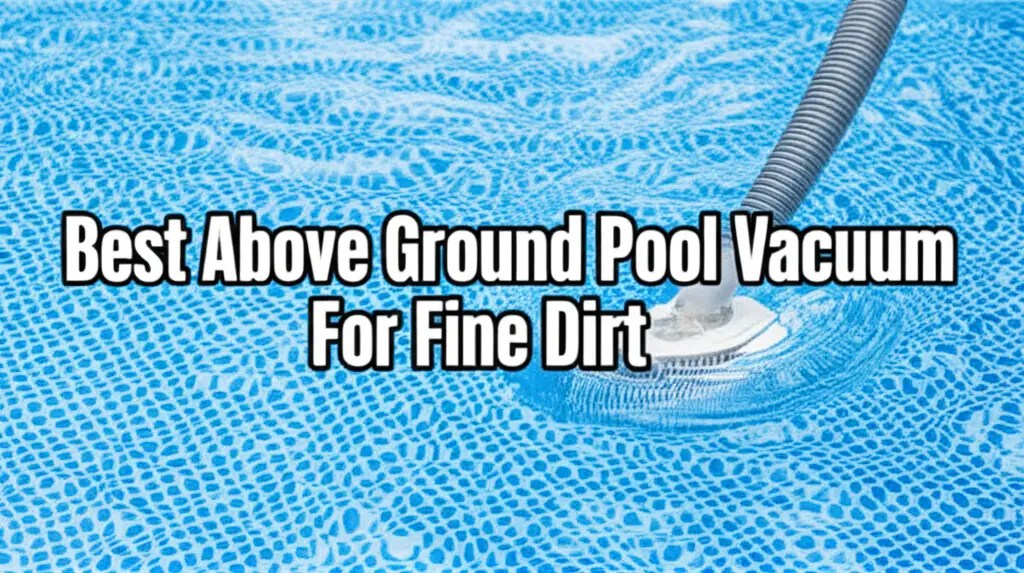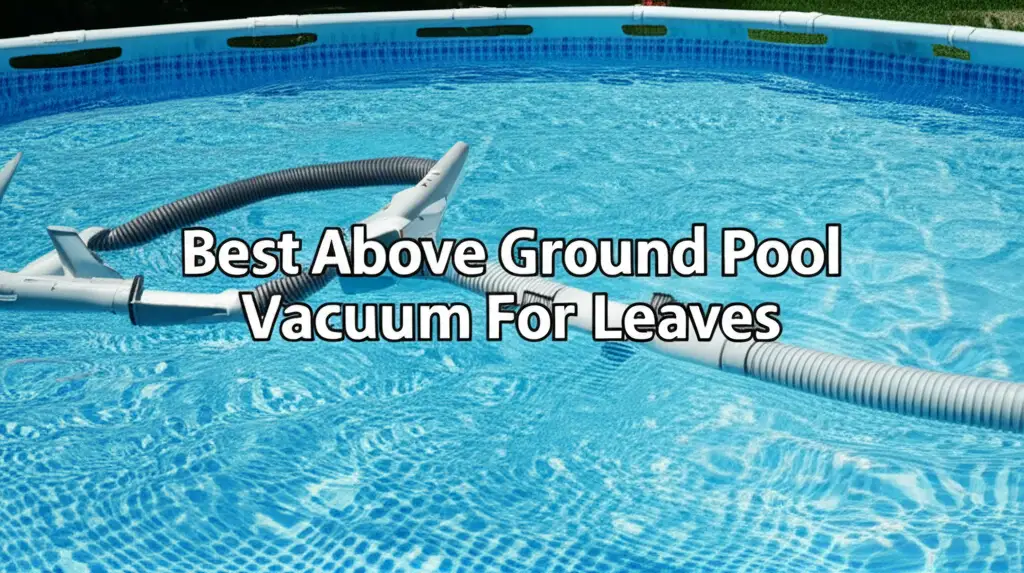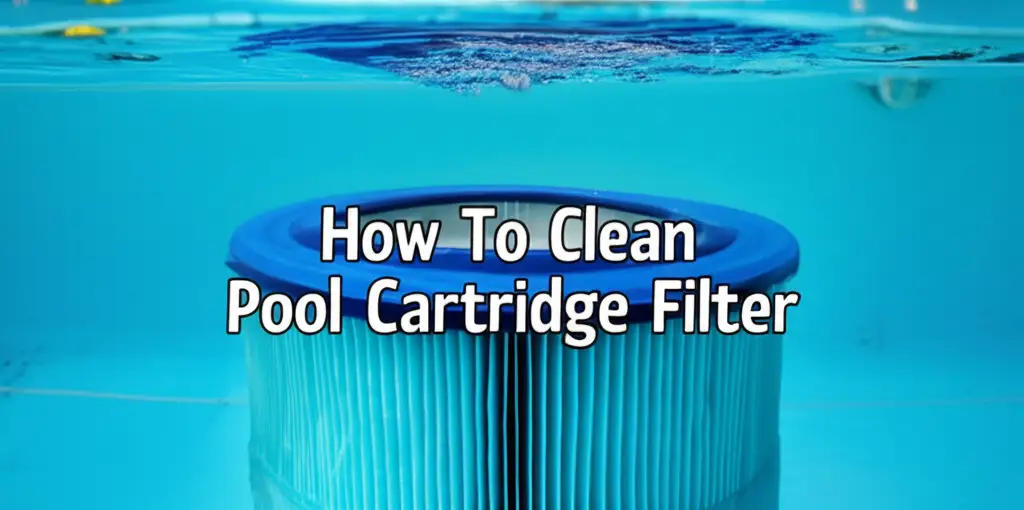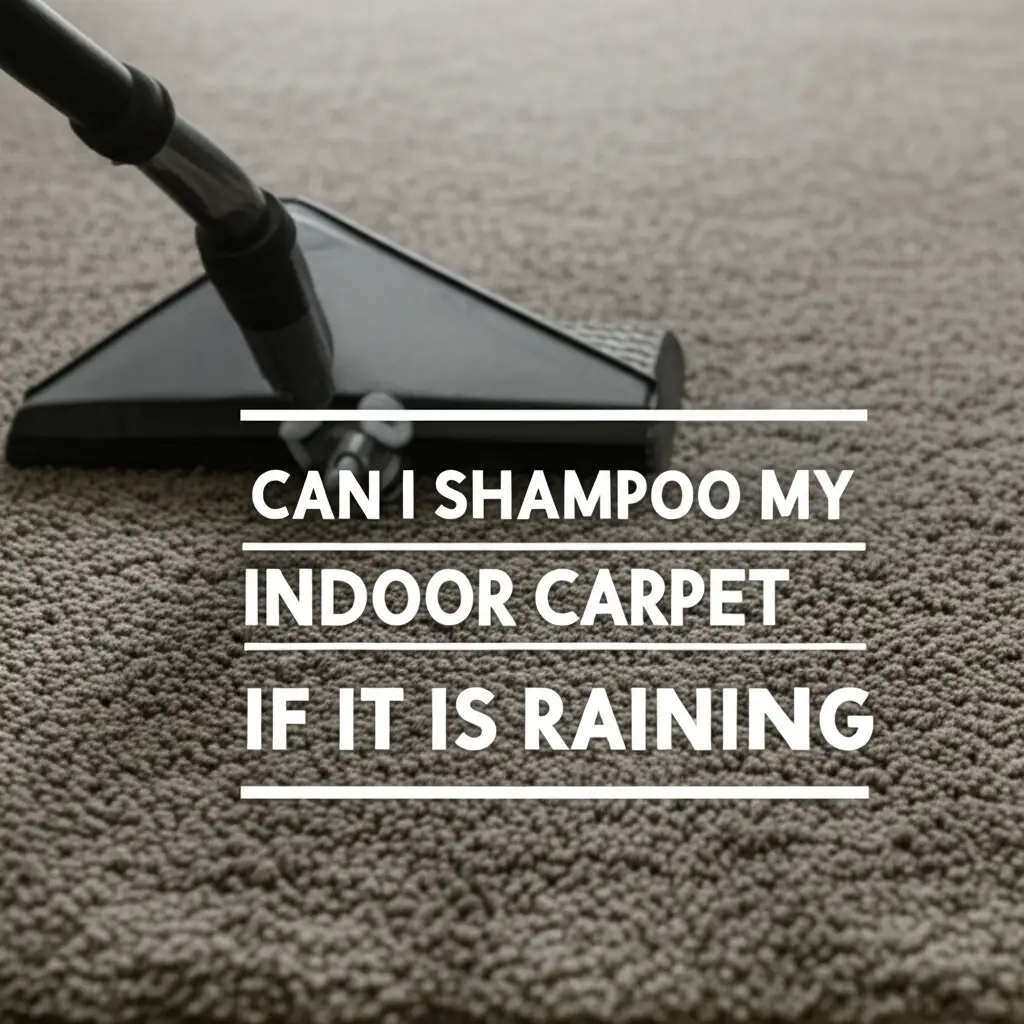· Mason Everett · Pool Maintenance · 16 min read
Best Above Ground Pool Vacuum For Sand
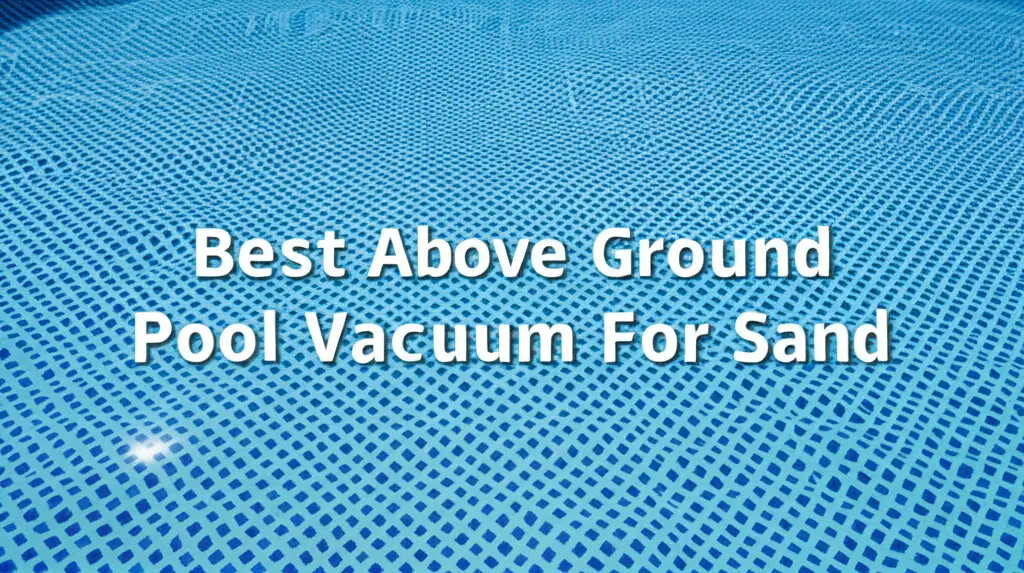
Finding the Best Above Ground Pool Vacuum for Sand
Keeping your above ground pool clean is important. Sand, dirt, and fine debris can quickly settle on the bottom, making your water cloudy and less inviting. If you own an above ground pool, you know the challenge of keeping it spotless, especially when dealing with tiny sand particles. Finding the best above ground pool vacuum for sand is not just about having a tool; it is about ensuring clear, sparkling water for enjoyable swimming. This guide helps you choose the right pool vacuum to tackle sand. I will discuss different vacuum types, essential features, and how to maintain your pool effectively.
Takeaway
- Choose a pool vacuum designed for fine debris and powerful suction.
- Consider robotic or pressure-side vacuums for automatic cleaning.
- Regular maintenance, including filter cleaning, is key for a sand-free pool.
The best above ground pool vacuum for sand is one that offers strong suction, handles fine particles without clogging, and integrates well with your pool’s filtration system. Look for features like wide cleaning paths and durable construction to efficiently remove stubborn sand from your pool floor.
Understanding How Sand Gets into Your Above Ground Pool
Sand often finds its way into your above ground pool through several common ways. Knowing these sources helps you take steps to prevent excessive build-up. This problem is common for many pool owners, and it requires a targeted approach to solve it.
Common Sources of Pool Sand
First, swimmers themselves often track sand in on their feet and swimwear. If your pool is near a sandy area, like a beach or a sandbox, it is almost impossible to avoid this. Children playing nearby can also kick up sand. We usually advise rinsing off before entering the pool.
Second, environmental factors play a big role. Wind can carry sand and fine dirt particles from nearby construction sites or even your own yard directly into the pool water. Heavy rain can also wash sand from surrounding areas into the pool, especially if your pool deck or landscaping is not properly graded. These natural elements are tough to control completely.
Third, sometimes the sand can come from your pool’s own sand filter. If your sand filter has a broken lateral or an issue with its internal components, it can push sand directly back into the pool. This is a sign of a faulty filter and requires immediate attention. You might see a sudden increase in sand on the pool floor in this case. Checking your filter regularly helps catch this issue early.
Types of Above Ground Pool Vacuums Ideal for Sand
Choosing the right type of pool vacuum is essential for effective sand removal. Not all vacuums are created equal when it comes to tackling fine debris. I have found that certain designs handle sand much better than others.
Manual Pool Vacuums for Sand
Manual pool vacuums are simple tools that you operate by hand. They connect to your pool’s skimmer or a dedicated vacuum line. You push them along the pool floor, and they suck up debris. These vacuums are affordable and give you complete control over the cleaning process. However, they require time and effort, especially for larger pools. When dealing with sand, ensure your manual vacuum has a large enough hose and a powerful pump to prevent clogging. A fine mesh bag attachment can also trap tiny sand particles before they reach your filter.
Suction-Side Pool Vacuums
Suction-side pool vacuums connect to your pool’s skimmer or a dedicated suction port. They use your pool pump’s suction to move around the pool and collect debris. These are relatively affordable and easy to set up. They work well for daily cleaning and can pick up fine sand. The main drawback is that they use your pool’s existing filter system, which means sand goes directly into your pump basket and then to the filter. You will need to clean your pool cartridge filter more often when using a suction-side cleaner for sand. This can put extra strain on your pump and filter.
Pressure-Side Pool Vacuums
Pressure-side pool vacuums connect to the return jet line of your pool, using the pressurized water from your pump to move and collect debris. Unlike suction-side models, they have their own filter bag. This feature is a big advantage when vacuuming sand because the sand is captured in the cleaner’s bag before it reaches your pool filter. This reduces the burden on your main filtration system. They are generally more expensive than suction-side cleaners but are very effective at picking up various types of debris, including fine sand. They are an excellent choice for pools with heavy sand problems.
Robotic Pool Vacuums for Sand
Robotic pool vacuums are independent units that operate without connecting to your pool’s filtration system. They have their own motor, internal filter, and often intelligent navigation. You simply plug them in, drop them in the pool, and let them do the work. These vacuums are highly efficient at collecting all sorts of debris, including very fine sand. They usually have strong suction and very fine filtration systems designed to capture tiny particles. While they are the most expensive option, they offer convenience and superior cleaning performance. Robotic cleaners are a top choice for busy pool owners who want the most effective sand removal. Many models can even climb walls and clean the waterline, adding to their value.
Key Features to Look for in a Sand-Fighting Pool Vacuum
When you are looking for the best above ground pool vacuum for sand, specific features make a big difference. These characteristics ensure the vacuum can effectively capture and contain fine particles without causing problems for your pool system. I always check for these key elements before making a choice.
Powerful Suction Capability
A pool vacuum must have strong suction to lift sand and fine silt from the pool floor. Sand is dense and settles quickly, so weak suction will just stir it up. Look for models that boast high flow rates or powerful motors. For manual vacuums, ensure your pool pump is robust enough to provide the necessary suction. Powerful suction ensures that the sand is picked up efficiently rather than pushed around.
Fine Filtration System
This is perhaps the most critical feature for sand removal. Sand particles are tiny, so your vacuum needs a filter capable of trapping them.
- Micron Rating: A lower micron rating means the filter can capture smaller particles. For sand, aim for a vacuum with a filter bag or cartridge that can filter down to 50 microns or less.
- Filter Bag/Cartridge Design: Some robotic and pressure-side cleaners come with large, easy-to-clean filter baskets or pleated cartridges. These are excellent for containing large amounts of sand without clogging quickly.
Non-Clogging Design
Sand can easily clog hoses, vacuum heads, and internal components. A good sand vacuum has a design that minimizes blockages. Look for wide intake ports on the vacuum head. Hoses should have a smooth interior to prevent sand from sticking and building up. Some vacuums include anti-clogging technology or larger debris passages. This ensures continuous cleaning without constant interruptions.
Weight and Maneuverability
For manual vacuums, the weight of the vacuum head is important. A heavier head helps keep it on the pool floor, ensuring better contact for sand removal. For automatic or robotic cleaners, good maneuverability is key. They should be able to navigate the pool’s contours and corners effectively. Look for models with swiveling hoses or intelligent navigation systems that prevent tangling and ensure thorough coverage. This allows the vacuum to reach all areas where sand might settle.
Durability and Build Quality
Pool vacuums work in harsh conditions, exposed to water, chemicals, and sunlight. Choose a vacuum made from durable, corrosion-resistant materials. Look for sturdy wheels, robust connectors, and high-quality plastics. A well-built vacuum will withstand regular use and provide reliable sand removal season after season. Investing in a durable model saves you money and hassle in the long run.
Tips for Efficient Sand Removal and Pool Maintenance
Effectively removing sand from your above ground pool involves more than just having the right vacuum. It also requires specific techniques and a consistent maintenance routine. I have found these tips make a significant difference in keeping sand out of my pool.
Vacuuming Technique for Sand
When vacuuming sand, go slowly. Moving the vacuum head too quickly will stir up the sand, making the water cloudy and allowing particles to resettle. Use gentle, overlapping strokes. Direct the discharge from your pump away from the sand areas as you vacuum. This prevents the water return from disturbing the settled sand.
For heavy sand accumulation, consider vacuuming to waste. This bypasses your filter and sends the dirty water directly out of the pool. It is especially useful for a large amount of sand or silt. Remember that vacuuming to waste lowers your pool’s water level, so be ready to add fresh water back in. This technique protects your filter from being overwhelmed.
Regular Pool Filtration and Circulation
Your pool’s filtration system is the first line of defense against sand and other debris. Ensure your pump runs long enough each day—typically 8-12 hours—to turn over all the water at least once. Proper circulation helps keep debris suspended, making it easier for the filter to capture. Make sure your return jets are angled to create a swirling motion in the pool. This helps push debris towards the main drain or skimmer.
Keep your pool filter clean. A dirty filter cannot effectively remove fine sand particles. For cartridge filters, rinse them regularly. For sand filters, backwash them when the pressure gauge indicates it. Regularly cleaning your pool cartridge filter or backwashing your sand filter is essential for optimal performance. This simple step greatly improves your filter’s ability to trap sand.
Skimmer and Pump Basket Maintenance
Your skimmer basket catches larger debris before it reaches your pump. Check and empty your skimmer basket daily, especially during windy conditions or heavy use. A full skimmer basket reduces the flow of water to your pump, decreasing vacuum suction. Similarly, regularly clean your pump’s strainer basket. These baskets are designed to protect your pump impeller from large debris. Keeping them clear ensures your pump runs efficiently, providing the strong suction needed to pick up sand.
Chemical Balance and Water Clarity
Proper water chemistry is vital for overall pool health and clarity. Balanced pH, alkalinity, and sanitizer levels help prevent algae growth and keep water sparkling. Cloudy water can make it harder to spot settled sand. Using a clarifier can help coalesce tiny sand particles into larger clumps. These larger clumps are easier for your filter to capture. Always test your pool water regularly and adjust chemicals as needed. Clear water makes spotting and removing sand much simpler.
Top Picks: Recommended Above Ground Pool Vacuums for Sand
Choosing the right above ground pool vacuum for sand can feel overwhelming with many options available. I want to highlight some types and specific features that often perform best for this particular challenge. These recommendations focus on effectiveness, ease of use, and durability when facing fine sand.
Best for Manual Control: Water Tech Pool Blaster Max Li
If you prefer a manual approach but want more power than a simple hose vacuum, battery-powered handheld vacuums are excellent. The Water Tech Pool Blaster Max Li is a standout in this category. It operates independently, meaning it does not connect to your pool’s filter system. It has its own strong motor and a fine filter bag designed to capture silt and sand. You just charge it, turn it on, and guide it. I find this type of vacuum incredibly effective for spot cleaning or for smaller above ground pools. It prevents sand from going through your main filter, which is a huge benefit.
Best Suction Side: Hayward W3DVX500CP AquaNaut 200
For a reliable suction-side cleaner, the Hayward AquaNaut 200 is a solid choice. While suction-side cleaners send debris to your main filter, this model is known for its strong suction and ability to handle various pool surfaces. Its programmed steering ensures good coverage, and it is designed to pick up both large and small debris. For sand, ensure your pool pump is powerful enough. Remember to clean your pool cartridge filter more often when using this type of vacuum for sand. This model offers good value for its performance.
Best Pressure Side: Polaris 65 3-Wheel Pressure Pool Cleaner
The Polaris 65 is specifically designed for above ground pools and works as a pressure-side cleaner. It connects to the return line and uses its own filter bag to collect debris. This is a significant advantage for sand because the sand is trapped in the Polaris’s bag, not your pool’s filter. It moves well around the pool and is efficient at collecting sand, leaves, and other debris. It is a durable cleaner that offers excellent performance for daily maintenance and sand removal without stressing your primary filtration.
Best Robotic: Dolphin Nautilus CC Plus
For the ultimate convenience and cleaning power, a robotic pool vacuum like the Dolphin Nautilus CC Plus is hard to beat. This robot operates completely independently from your pool system. It has its own powerful motor, intelligent navigation, and dual filter cartridges that are excellent at trapping very fine sand and silt. You just drop it in, and it cleans the floor and walls automatically. While a higher investment, the Dolphin Nautilus CC Plus offers superior cleaning results, especially for fine sand, and reduces the workload on your pool filter. I highly recommend it for consistent, thorough sand removal.
Maintaining Your Pool Filter After Vacuuming Sand
After vacuuming sand from your above ground pool, especially with certain types of vacuums, your pool filter will work hard. Proper maintenance of your filter system is crucial to ensure it continues to function effectively and keeps your water clear. Neglecting your filter can lead to cloudy water or even damage to your equipment.
Cartridge Filter Cleaning
If you have a cartridge filter and vacuumed sand with a manual or suction-side cleaner, your cartridge likely caught a lot of fine particles. You need to remove the cartridge and rinse it thoroughly with a hose. Use a strong spray to dislodge sand and debris from the pleats. For stubborn sand or accumulated dirt, consider using a specialized pool cartridge filter cleaning solution. These solutions help break down oils and trapped particles. Allow the cartridge to dry before reinstalling it if possible, as this can help remove even more dirt. Regular cleaning prevents the filter from becoming clogged and maintains optimal water flow.
Sand Filter Backwashing
For sand filters, backwashing is the key step after vacuuming sand. When you vacuum sand, it gets trapped within the sand bed of your filter. As the sand accumulates, it increases pressure within the filter, reducing its efficiency. Monitor your pressure gauge; when it rises 8-10 PSI above its normal operating pressure, it is time to backwash. To backwash, turn off your pump, set the filter valve to “backwash,” and turn the pump back on. Run it until the water in the sight glass runs clear, usually for 2-3 minutes. Then, switch to “rinse” for 30-60 seconds to re-settle the sand. This process flushes the trapped sand out of your filter and into a waste line.
D.E. Filter Cleaning
If you have a D.E. (Diatomaceous Earth) filter, vacuuming sand will also impact its performance. D.E. filters offer the finest filtration, making them excellent at trapping sand. However, they require more involved maintenance. After vacuuming heavy sand, you will likely need to “bump” the filter or perform a full backwash and recharge. Bumping dislodges the D.E. from the grids, allowing trapped sand to fall to the bottom, which can then be flushed. For a full clean, you backwash the D.E. out, then add fresh D.E. powder back into the skimmer. Always follow your manufacturer’s instructions for D.E. filter maintenance.
Importance of Regular Filter Checks
Regardless of your filter type, make it a habit to check its performance regularly after heavy cleaning sessions. A clean filter ensures maximum suction for your vacuum and overall water clarity. Neglecting filter maintenance leads to reduced water flow, cloudy water, and inefficient sand removal. It also puts unnecessary strain on your pool pump. A well-maintained filter extends the life of your pool equipment and keeps your water pristine.
FAQ Section
How often should I vacuum my above ground pool for sand?
You should vacuum your above ground pool for sand at least once a week, or more frequently if you notice significant accumulation. After heavy rain, windy conditions, or high swimmer traffic, a quick vacuum might be necessary. Regular vacuuming prevents sand from building up and becoming harder to remove.
Can I use a regular shop vac to clean sand from my pool?
No, you should not use a regular shop vac for pool sand. Shop vacs are not designed for submerged use and can be an electrical hazard. They also do not have the proper filtration to handle water and fine sand effectively. Always use a vacuum specifically designed for pools.
Will vacuuming sand damage my pool filter?
Vacuuming a small amount of sand usually does not damage your pool filter. However, vacuuming large amounts of very fine sand through your main filter system can put strain on it. It can reduce filter efficiency and require more frequent cleaning or backwashing. Using a vacuum with its own filter bag helps prevent this.
What causes cloudy water after vacuuming sand?
Cloudy water after vacuuming sand often happens because you stirred up the fine particles. Your filter system might not be catching all of them immediately. Ensure your filter is clean and running efficiently. Sometimes, adding a pool clarifier can help tiny sand particles clump together, allowing your filter to capture them more easily.
Can I prevent sand from getting into my above ground pool?
You can reduce the amount of sand getting into your pool. Encourage swimmers to rinse off before entering the water. Consider placing mats or a small area of artificial turf around the pool entrance. For sand from your yard, improve drainage and landscaping to direct runoff away from the pool.
How do I know if my pool filter is putting sand into my pool?
If you consistently find sand on the bottom of your pool, and it is not from external sources, your sand filter might be the culprit. Check your filter’s laterals for damage, or the multi-port valve may be faulty. If you suspect your filter, consult a pool professional for inspection and repair.
Conclusion
Choosing the best above ground pool vacuum for sand is an important step toward maintaining a clean and enjoyable swimming environment. We have explored various types of vacuums, from powerful manual options to convenient robotic cleaners. Each type offers unique benefits for tackling fine sand and debris. Key features like strong suction, fine filtration, and anti-clogging designs are crucial for effective sand removal.
Remember that the right vacuum works best when combined with smart cleaning techniques and diligent filter maintenance. Whether you opt for a handheld unit, a suction-side model, a pressure-side cleaner, or a fully automatic robot, keeping your pool sparkling requires consistency. By understanding how sand enters your pool and implementing these strategies, you can ensure your above ground pool remains a clear, inviting oasis for years to come. Invest in the right tool and establish a good cleaning routine to enjoy a sand-free pool all season long.
- above ground pool
- pool vacuum
- sand removal
- pool cleaning
- fine debris
- pool maintenance
- automatic pool vacuum
- manual pool vacuum


